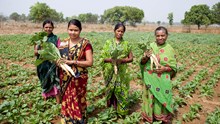
Mountains are essential to our planet, offering more than just scenic landscapes—they are important hubs for biodiversity, water storage, and agricultural productivity. On International Mountain Day, we recognize the significant horticultural wealth of India’s hilly regions- the Himalayas, the Northeast, and the Western Ghats- which produce high-value crops like fruits, vegetables, spices, and medicinal plants that contribute greatly to the national economy and global food systems.
In these areas, horticulture is much more than mere cultivation; it is a cultural legacy and a testament to human resourcefulness. Farmers adapt to steep terrains, harsh climates, and scarce resources by developing sustainable practices that are as strong as the mountains themselves.
Significance of Horticulture in Hilly Areas
There exist several advantageous conditions of hilly tracts for horticulture, while a cool climate supports growth conditions for temperate fruits - apples, pears, cherries, and plums; in particular microclimates, spices cardamom, and turmeric have unique varieties. These micro-climate suitable vegetables are potatoes and cabbage; while some particular valuable medicinal crops, i.e., saffron, rosemary; the benefits to diet are considerable, with possibilities also as a means of creating extra income streams by being valued-added like juice or jelly or herbs and medications preparations.
Additionally, the cultivation of orchards and other perennial crops in these areas helps to combat soil erosion, maintain water tables, and act as carbon sinks. Horticulture in hilly terrains incorporates the principles of sustainable development, balancing economic growth with environmental management.
Role of Favorable Factors in Horticulture Development
Hilly area horticulture depends on several interrelated factors, including climate, soil quality, topography, water availability, altitude, and the selection of suitable crops that can thrive in these specific conditions. Let’s discuss:
1. Land and Altitude
The altitudes of hilly regions influence temperature, making them suitable for cultivating specific crops like apples, pears, and cardamom. The terrain's slope helps with drainage but requires careful soil conservation techniques such as terrace farming. Varied altitude zones in the Himalayas—from sub-tropical to alpine belts—offer distinct microclimates for diverse crop growth.
2. Climate and Rainfall
Hilly regions experience unique microclimates dictated by altitude, slope, and wind direction. Rainfall patterns vary, with higher altitudes receiving more precipitation. However, challenges like cloudbursts and localized floods impact crop cultivation. The sunny south-facing slopes are better for crops needing higher light intensity, while shaded northern slopes support shade-tolerant varieties.
3. Soil Composition
The soil in hilly areas varies in fertility. River valleys have nutrient-rich alluvial soils, while upper terraces often suffer from low organic matter and nitrogen. However, the natural process of mineral transformation and human interventions like organic farming improves soil health.
4. Manpower and Literacy
Hilly regions typically have lower population density and literacy rates due to limited infrastructure. Despite these challenges, local farmers’ traditional knowledge and growing access to modern agricultural techniques are transforming these areas into horticultural hubs. Increasing literacy among the rural populace enhances their understanding of sustainable practices and economic opportunities.
Integration in Horticultural Practices
The unique interplay of these factors allows hilly regions to e in producing high-value crops like temperate fruits (apples, cherries), spices (cardamom, turmeric), and medicinal plants. For example, Himachal Pradesh and Uttarakhand specialize in apple farming because of their cool climates, while Sikkim focuses on organic cardamom production.
Modern techniques like multilayer farming, drip irrigation, and organic manure application enhance productivity further. The farmers are gradually adopting sustainable practices to conserve soil and water, protect biodiversity, and maximize yields.
Challenges in Hilly Regions
Farming in the hills has its challenges. Sloping terrain leads to soil erosion, erratic rainfall, and climate change pose threats to crop cycles. Limited access to markets and transport facilities often results in post-harvest losses, hence reducing profitability for farmers. Traditional farming also can be labour-intensive and, by lack of mechanization, this burden is increased.
Despite all these, the mountain farmers do not give up but continue to have their innovative techniques, such as terrace farming, agroforestry, and natural fertilizers.
Market Value of Horticultural Products
The market value of horticultural products from hilly areas is high due to their quality and uniqueness. For example, Himachal apples and Sikkim’s cardamom fetch premium prices in domestic and international markets. Organic produce from these regions is in demand, further enhancing their economic potential.
Ecologically, the adaptability of hilly crops ensures their growth in diverse conditions. Crops like apples require chilling hours during winters, while medicinal plants thrive in nutrient-rich mountain soils. These adaptations make mountain horticulture not just viable but essential for ecological balance and food security.
Efforts have been made to introduce modern practices and sustain and expand horticulture in hilly regions. Techniques like drip irrigation are gaining popularity as they can reduce resource usage while offering improved yield. The farmers are able to access greater markets with the introduction of cold storage facilities and cooperative marketing.
Training programs and government initiatives, such as Krishi Vigyan Kendras, are empowering farmers with technical know-how, which helps them adopt sustainable practices. Empowering the communities to see horticulture not just as a means of livelihood but as a way of preserving their cultural and natural heritage is important.
On International Mountain Day, we celebrate the vital role of hilly area horticulture in global food security and ecological conservation. The communities in these regions show how agriculture can be sustainable, profitable, and environmentally connected. By supporting these practices through innovation, policy, and awareness, we can help mountain agriculture thrive for future generations.
















